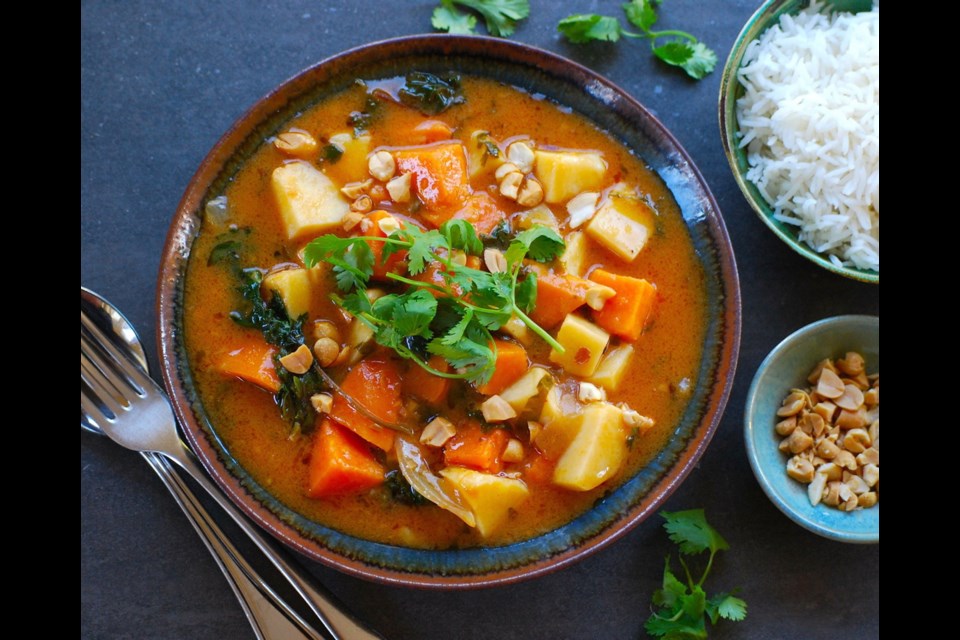Given how plentiful they are in autumn, it’s no wonder you’ll see mounds of sweet potatoes and yams for sale at supermarkets around Thanksgiving.
But did you know that one of them has been posing as another type of vegetable for generations?
When buying them you’ll notice they have a similar shape and size and there’s a good reason: they’re both varieties of sweet potato.
The story goes that, decades ago, an American seller decided to call the copper-skinned, orange-fleshed variety of sweet potato a yam. He did that to help distinguish it from the tan-skinned, pale-yellow-fleshed type, which is still called a sweet potato.
Calling it a yam was an odd decision, given that a sweet potato is not a yam. According to The New Food Lover’s Companion, a “true” yam is from a different plant species and is a staple ingredient in places such as South America and Central America, as well as some Asian and African countries. It can be much larger than a sweet potato and has a light flesh and rough skin that’s peeled before cooking.
While real yams have never been widely available here, orange-fleshed sweet potatoes have, and we obviously bought into the idea of calling them yams. The upside is that it did help distinguish it from the pale-yellow-fleshed type.
Orange-fleshed sweet potatoes, a.k.a. yams, are denser, moister and sweeter than the pale-yellow-fleshed variety. The latter variety is also starchier and nuttier in flavour. Because of those differences, they are suited to different styles of preparation.
For example, if you need a sweet potato to hold its shape when cooked for use in a salad, while also adding a vibrant colour, the orange-fleshed variety is best. The yellow-fleshed variety, because it’s starchy like a baking potato, is great for roasting, frying or boiling and mashing.
Both types can be combined in a dish, as I did in my coconut-milk-based, Thai-style curry recipe. The paste flavouring the curry is sold in small jars at most supermarkets.
Serve the curry with steamed white or brown jasmine rice. While enjoying it, take heart in the fact that sweet potatoes, even if you call one of them a yam, are nutritious, containing such things as vitamin A, C, D and B and many minerals.
��
Thai-style Yam and Sweet Potato Curry
This seasonal, meat-free curry has a mild to medium spice level. Add a bit more curry paste if you prefer a spicier taste. If you’re cooking for one, the leftover curry will freeze well.
��
Preparation time: 25 minutes
Cooking time: About 20 minutes
Makes: three servings
��
1 (400 mL) can coconut milk
2/3 cup vegetable stock, plus more if needed
2 Tbsp lime juice
1 Tbsp cornstarch
1 Tbsp brown sugar
1 Tbsp soy sauce
2 tsp Thai-style fish sauce (optional; see Note)
2 Tbsp vegetable oil
1/2 medium onion, sliced
2 cups (about one pound) sweet potato, cut 1-inch cubes
2 cups (about one pound) yams (orange-fleshed sweet potatoes), cut 1-inch cubes
1 Tbsp chopped fresh ginger
1 Tbsp red or green Thai curry paste
2 cups loosely packed baby kale (see Note)
1/4 cup chopped fresh cilantro, plus a few sprigs for garnish
3 Tbsp coarsely chopped, unsalted, roasted peanuts (optional; see Note)
Place coconut milk, 2/3 cup stock, lime juice, cornstarch, brown sugar, soy sauce and fish sauce, if using, in a bowl and whisk to combine.
Place the oil in medium-sized pot (mine was eight inches wide; four inches tall) and set over medium to medium-high heat. Add the onion, sweet potatoes, yams and ginger and cook and stir four to five minutes. Add the curry paste and cook and stir one minute more.
Give the coconut milk mixture another whisk, and then pour into the pot. Bring mixture to a gentle simmer, adjusting the heat as needed to maintain that simmer.
Simmer curry, uncovered, until sweet potatoes and yams are tender, about 10 to 12 minutes. Mix in kale and chopped cilantro and cook until kale is wilted and just tender, about two minutes. Thin curry with a bit more stock, if you find it too thick.
Garnish servings of the curry with cilantro sprigs and chopped peanuts, if using.
Note: Pungent, Thai-style fish sauce is sold in the Asian foods aisle of most supermarkets. Baby kale is sold in tubs in the produce section of many supermarkets. If you can’t find it, use baby spinach in this recipe. Unsalted, roasted peanuts are sold in the bulk foods section of some supermarkets and at bulk food stores.
Eric Akis is the author of eight cookbooks. His columns appear in the Life section Wednesday and Sunday.



